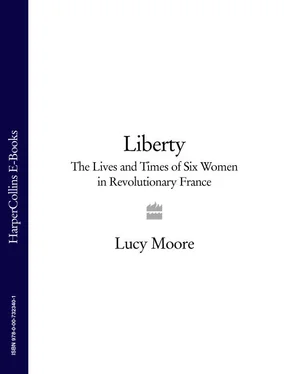Although the constitution of the newly formed United States had not granted rights to women, its democratic example was an inspiration to Condorcet. ‘Men whom the reading of philosophic books had secretly disposed to love liberty were filled with passion [during the War of Independence],’ he wrote in a eulogy to Benjamin Franklin. ‘They seized with joy this occasion to publicly confess sentiments that prudence had obliged them to maintain in silence.’
England provided Germaine's circle with another social and political model; collectively, they were known as ‘Anglomaniacs’. Helen Maria Williams described the French in 1789 and 1790 as ‘mad about the English’. So-called English pastimes of racing and betting preoccupied the upper classes' leisure time; young aristocrats affected English accents and a deliberate awkwardness of manner, because the English were famously clumsy. ‘Everything had to be copied from our neighbours, from the Constitution to horses and carriages,’ wrote Lucy de la Tour du Pin, whose Irish blood and fair English looks made her a sensation at court.
In the first half of the eighteenth century, the political philosopher Montesquieu had applauded Britain's well balanced, representative government. English customs were seen as an ideal combination ‘of privilege and liberty, elegance and easy informality, tradition and reform’, and English men and women were praised by French visitors for their cleanliness, motivation and industry. Germaine thought England had ‘attained the perfection of the social order’, with its division of power between Crown, aristocracy and people. But even to speak of the English constitution at court ‘seemed as criminal as if one had suggested dethroning the king’.
Away from court, beneath the Gobelin tapestries on the walls of the dining-room in the rue du Bac, there were no such restrictions on speech or thought. In her favourite stance with her back to the fireplace, Mme de Staël, ‘young, brilliant [and] thoughtless’, would captivate her own coterie of dazzled youths by proclaiming ‘in strokes of fire the ideas they thought they held’.
On 5 May 1789, from a palace window, an ecstatic Germaine watched the deputies of the Estates-General process into their opening session at Versailles. They had last gathered together 175 years earlier. Among the deputies Germaine's rejected suitor, Stanislas de Clermont-Tonnerre, represented the royalist centre right; her friend Lafayette was a moderate constitutional monarchist; the three Lameth brothers and Mathieu de Montmorency, all of whom had fought beside Lafayette in America, were slightly more liberal; on the extreme left were the lawyers Maximilien Robespierre, François Buzot and Jérôme Pétion.
Perhaps the most celebrated deputy in 1789 was Honoré-Gabriel de Mirabeau, the debauched Provençal count who represented his region in the Third Estate, the commoners, instead of sitting with the peers. The inspiring beauty of his oratory was almost enhanced by its contrast with his physical brutishness and coarse, pock-marked face. Germaine despised him: he was her father's rival for the hearts of the people. Blinded by his weaknesses—egotism and immorality—she could not see the political talents he possessed in abundance. Necker dismissed Mirabeau as ‘a demagogue by calculation and an aristocrat by disposition’.
On the streets of Versailles, crowds ‘drunk with hope and joy’, according to another observer, lined the route to wish the Estates-General well, but Mme de Montmorin, the wife of a royal minister standing beside Germaine, was pessimistic. ‘You are wrong to rejoice,’ she said to Germaine. ‘This will be the source of great misfortune to France and to us.’ She was right, as far as she and her family were concerned: she would die on the scaffold beside one of her sons; another son drowned himself; her husband and one daughter died in prison and another daughter died before she was thirty.
Maximilien Robespierre was invited to Necker's Versailles residence later that summer. Deputies to the National Assembly *were much in demand in the grand salons of Paris and Versailles. ‘His features were ignoble, his skin pale, his veins of a greenish colour,’ Germaine recalled. ‘He supported the most absurd propositions with a coolness that had the air of conviction.’ From the start, Robespierre saw himself as France's saviour. ‘ La patrie est en danger ,’ he had written in April 1789. ‘Let us fly to its aid.’ A provincial lawyer from a modest but comfortable background (at the start of the revolution he signed his name using the aristocratic ‘de’), he became a regular speaker at the National Assembly and was already attracting attention for his lofty democratic principles, arguing in favour of freedom of the press and insisting suffrage should be granted to all men, including servants and the poor; he did not mention votes for women.
Alongside Germaine's friends Lafayette and the Lameth brothers, Robespierre was a prominent member of a club formed at Versailles in the summer of 1789 by a group of progressive deputies with the purpose of debating issues before they came before the National Assembly. The Society of the Friends of the Constitution would become known as the Jacobin Club because, when the Assembly moved to Paris that October, they hired the hall of a Dominican ( Jacobin , in French slang) monastery on the rue Saint-Honoré, almost opposite the manège where the Assembly met.
As her opinions of Robespierre and Mirabeau demonstrate, Ger-maine's view of politics was intensely personal, coloured by her firsthand observation of people and her sense of being at the centre of events. She called Clermont-Tonnerre ‘my speaker’, meaning speaker on her behalf in the Assembly, and in September 1789 she scribbled an urgent note to Monsieur de Staël in Versailles to find out whether or not ‘my bill on the veto’ (whether or not the king should have a veto over legislation in the new constitution, and if so how strong a veto) had been won; as she hoped, the ‘Necker–Lafayette’ partial veto had been adopted.
She had cause to feel possessive. In July, committees were created to compose France's first constitution, and on them sat many of Ger-maine's friends including Talleyrand, Lafayette and the Lameths. In August they produced the Declaration of the Rights of Man and the Citizen which established in its first article that all men are born and live free and equal. Torture and arbitrary imprisonment were abolished and innocence was presumed; freedom of the press and of worship was declared; citizens were to bear the weight of taxation according to their abilities; the army was defined as a public force and access to the officers' ranks opened up to non-nobles.
Even though the real work of composing a constitution was still to come, these basic liberties were exactly those for which Germaine had been agitating behind the scenes and, looking back on the achievements of this period, she remained certain that politics and society had never been so intimately or valuably connected. ‘As political affairs were still in the hands of the elite, all the vigour of liberty and all the grace of old-fashioned manners were united in the same people,’ she wrote. ‘Men of the Third Estate, distinguished by their enlightened ideas and their talents, joined those gentlemen who were prouder of their own merit than of the privileges of their class; and the highest questions society has ever considered were dealt with by minds the most capable of understanding and debating them.’
This self-referential, unabashedly elitist idea of ‘communication of superior minds among themselves’ was the spirit of Germaine de Staël's salon, and, though it was instrumental in bringing the revolution into being, it would have little place in it in the years to come. As Germaine herself said, from the day that the National Assembly moved from Versailles to Paris in the autumn of 1789, ‘its goal was no longer liberty, but equality’.
Читать дальше












